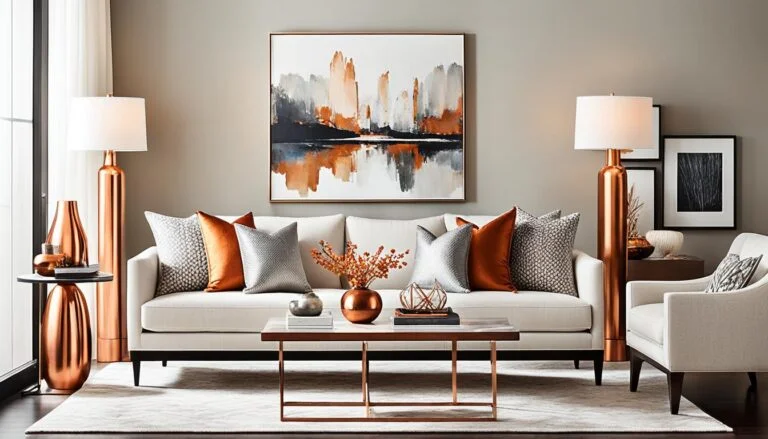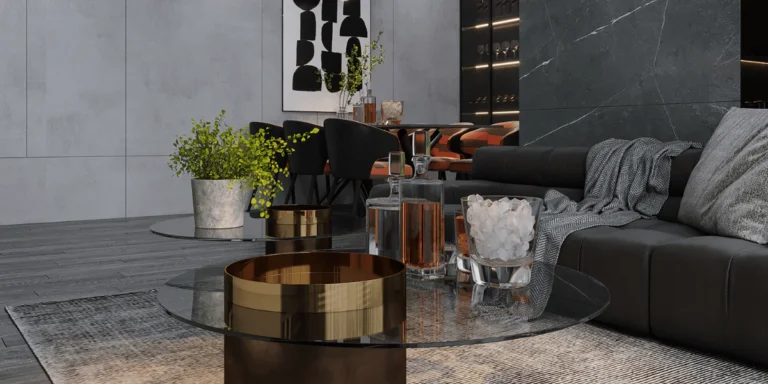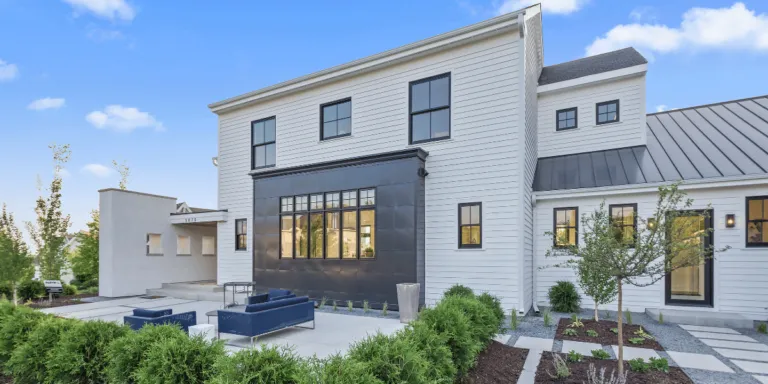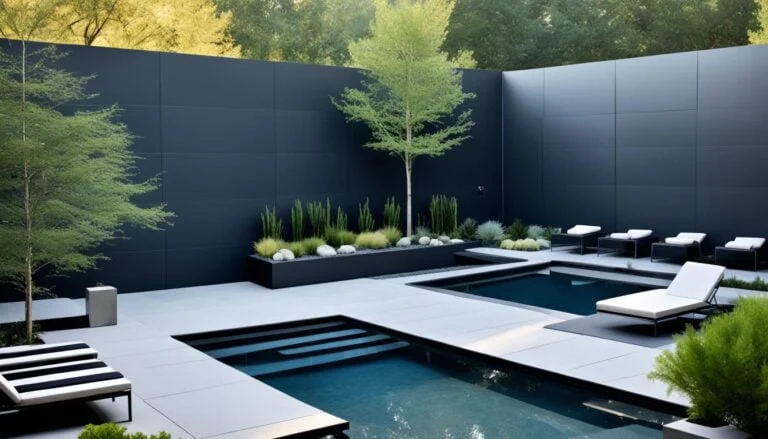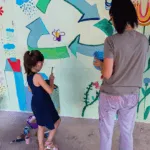Welcome to our article on integrating art in gardens, where we explore a creative approach that combines the beauty of art with sustainable urban gardening and eco-friendly landscape design. By harmoniously blending nature and artistic expression, this approach creates visually stunning outdoor spaces that promote environmental consciousness and creativity.
Integrating art in gardens goes beyond mere aesthetics. It involves incorporating sustainable urban gardening practices, such as using organic fertilizers, practicing water conservation, and selecting native plant species. This approach acknowledges the importance of eco-friendly landscape design techniques, which consider the long-term impact on the environment.
Whether it’s through sculptures, mosaics, or interactive installations, art has the power to transform gardens into captivating and sustainable spaces. By embracing innovative water conservation techniques, utilizing renewable energy sources, and creating wildlife habitats within gardens, we can elevate these outdoor sanctuaries to new heights.
In the following sections, we will delve deeper into the transformative power of art in gardens, the integration of technology in garden artistry, enhancing indoor spaces with art and nature, exploring the intersection of art and garden design, the impact of art in environmental education, and the benefits of arts integration in education. So, let’s embark on this journey of combining art and nature for a greener, more vibrant world.
Key Takeaways:
- Integrating art in gardens creates visually stunning and eco-friendly outdoor spaces.
- This approach combines sustainable urban gardening practices and eco-friendly landscape design techniques.
- Art in gardens can promote innovative water conservation techniques and renewable energy sources.
- Integrating technology in garden artistry enhances creativity and efficiency.
- Enhancing indoor spaces with art and nature creates harmonious and inspiring environments.
The Transformative Power of Art in Gardens
Art has the power to transform gardens into captivating and sustainable spaces. By incorporating innovative water conservation techniques, renewable energy sources, and elements that support wildlife, art in gardens can create environmentally conscious and visually stunning landscapes.
Innovative Water Conservation Techniques
Incorporating innovative water conservation techniques in garden design is essential for promoting efficient water usage and sustainability. Two effective methods are:
- Rainwater Harvesting: Installing rain barrels or cisterns to collect rainwater can provide a free source of water for plants and reduce reliance on municipal water supplies.
- Drip Irrigation Systems: Drip irrigation delivers water directly to the roots of plants, minimizing water wastage through evaporation and runoff.
Renewable Energy in Eco-Gardens Integrating Art in Gardens
Integrating renewable energy sources in eco-gardens not only reduces carbon emissions but also contributes to a more sustainable and self-sufficient garden ecosystem. One popular method is:
- Solar Panels: Installing solar panels in garden areas can harness the power of the sun to generate electricity, which can be used to power garden lighting, water features, or even charge electric garden tools.
Wildlife Habitat Garden Creation
Creating wildlife habitat gardens is a way to support local biodiversity, attract beneficial wildlife, and establish a balanced ecosystem. Some elements to consider incorporating into the garden are:
- Native Plants: Choosing native plants helps provide food and shelter for local wildlife while reducing the need for excessive watering and maintenance.
- Nesting Boxes: Installing nesting boxes can provide habitat for birds and small mammals, encouraging them to take up residence in the garden and contribute to natural pest control.
Art in gardens has the potential to go beyond aesthetics and make a positive impact on the environment. By incorporating innovative water conservation techniques, renewable energy sources, and creating wildlife habitat gardens, we can create beautiful, sustainable, and ecologically diverse spaces that inspire both humans and nature.
Embracing Technology in Garden Artistry
The integration of technology in garden artistry opens up new possibilities for creativity and efficiency. By incorporating high-tech smart gardening tools and systems, space-efficient vertical gardening techniques, and urban permaculture practices, gardens can thrive even in limited urban spaces while minimizing resource consumption.
High-Tech Smart Gardening
High-tech smart gardening tools and systems utilize advanced technologies to optimize plant growth and reduce environmental impact. Automated irrigation systems, equipped with smart sensors, deliver the right amount of water precisely when plants need it, minimizing water waste. Smart gardening systems can monitor and adjust factors such as temperature, humidity, and lighting, ensuring optimal growing conditions for plants.
Space-Efficient Vertical Gardening
Space-efficient vertical gardening techniques are ideal for urban environments with limited garden space. Vertical gardens and living walls utilize vertical surfaces to grow plants, maximizing the use of space. These innovative gardening methods not only add a touch of greenery to urban spaces but also provide a host of benefits, such as improved air quality, reduced noise pollution, and increased insulation.
Urban Permaculture Practices
Urban permaculture practices combine sustainable agriculture and design principles to create productive and eco-friendly gardens. Permaculture emphasizes working with, rather than against, natural systems. By incorporating companion planting, natural pest control methods, and composting, urban gardens can maximize yields while minimizing the use of chemical fertilizers and pesticides.
By embracing technology in garden artistry, individuals can create sustainable and thriving gardens, irrespective of the available space. Whether it’s a small balcony garden or a rooftop oasis, the integration of high-tech smart gardening, space-efficient vertical gardening, and urban permaculture practices can transform any urban space into a green haven.
Enhancing Indoor Spaces with Art and Nature
Integrating art and nature in indoor spaces can create a harmonious and inspiring environment. By bringing the beauty of nature indoors, we can transform our living and working spaces into calming and rejuvenating sanctuaries.
Indoor Hydroponic Systems
One innovative way to incorporate nature into indoor spaces is through the use of indoor hydroponic systems. These systems allow for the cultivation of plants without soil, making it possible to have a thriving garden indoors. Hydroponic systems utilize nutrient-rich water solutions that provide plants with the essential nutrients they need to grow and thrive. By eliminating the need for soil, indoor hydroponic systems are not only space-efficient but also reduce the risk of pests and diseases commonly associated with traditional gardening methods.
Organic Composting Methods
Another way to enhance indoor spaces with nature is by utilizing organic composting methods. Composting is the process of decomposing organic matter, such as food scraps and garden waste, into nutrient-rich soil amendments. Indoor composting bins or worm composting systems can be used to convert kitchen scraps into compost indoors. The resulting compost can be used to enrich indoor plants, providing them with the necessary nutrients for healthy growth. Composting not only reduces waste but also promotes sustainable practices and reduces the need for chemical fertilizers.
Green Roof Ecosystems
Green roof ecosystems offer a unique way to incorporate nature into indoor spaces while also providing numerous benefits. A green roof involves the installation of vegetation on rooftops, creating a mini-ecosystem that can replicate the functions of a natural landscape. Green roofs provide aesthetic beauty, improve insulation, and contribute to energy efficiency by reducing heat transfer and absorbing rainwater. They also provide habitat for birds, insects, and other wildlife, promoting biodiversity in urban environments. Creating a green roof ecosystem is not only visually appealing but also contributes to the overall sustainability of indoor spaces.
By embracing indoor hydroponic systems, organic composting methods, and green roof ecosystems, we can transform our indoor spaces into vibrant and sustainable environments that promote well-being and connection with nature.
Exploring the Intersection of Art and Garden Design
Contemporary garden artistry combines the principles of artistic expression with garden design to create outdoor spaces that are truly one-of-a-kind. By seamlessly integrating art into garden landscapes, a new level of visual captivation emerges, transforming ordinary gardens into extraordinary works of art. This blending of contemporary garden artistry not only enhances the aesthetic appeal of outdoor spaces but also brings together elements of nature, creativity, and functionality.
One key factor in creating stunning garden designs is the incorporation of biophilic design principles. These principles emphasize the innate connection between humans and nature, allowing for a deeper and more enriching garden experience. By incorporating natural elements, such as water features, native plantings, and organic forms, biophilic design principles can create a sense of harmony and tranquility within the garden.
Another exciting aspect of modern garden artistry is the integration of smart garden automation. With the advancement of technology and sensors, smart garden automation allows for the seamless operation and maintenance of gardens. Automated irrigation systems, ambient lighting controls, and climate monitoring systems are just a few examples of how technology can optimize the functionality of gardens while still preserving the artistic integrity.
Here is a table showcasing some key features of contemporary garden artistry:
| Contemporary Garden Artistry Features | Description |
|---|---|
| Integration of Biophilic Design Principles | Incorporation of natural elements and sustainable practices to enhance the overall garden experience. |
| Smart Garden Automation | Utilization of technology and sensors to automate tasks and optimize garden maintenance. |
| Artistic Expression | Integration of sculptures, installations, and other artistic elements to create visually captivating outdoor spaces. |
| Sustainable Materials | Selection of environmentally friendly materials and techniques to minimize the ecological impact. |
Overall, contemporary garden artistry exemplifies the harmonious merging of art and garden design. By embracing biophilic design principles, incorporating smart garden automation, and expressing artistic creativity, outdoor spaces can become truly transformative environments. The combination of these elements allows for a unique blend of beauty, functionality, and sustainability within garden landscapes.
The Impact of Art in Environmental Education
Art plays a crucial role in environmental education by nurturing pro-environmental mindsets and fostering a deeper connection with nature. Through arts-based environmental education programs, students are provided with hands-on artistic experiences that encourage them to explore, appreciate, and understand the natural world in a creative and engaging way.
By integrating art and science, students develop a holistic understanding of environmental issues and are empowered to take meaningful actions in creating sustainable futures. The combination of artistic expression and scientific knowledge cultivates a unique perspective that encourages students to approach environmental challenges with creativity, innovation, and a sense of responsibility.
Promoting Pro-Environmental Mindsets Through Arts-Based Environmental Education Programs
Arts-based environmental education programs leverage the power of artistic expression to promote pro-environmental mindsets among students. These programs provide a platform for students to explore environmental issues through various art forms, such as painting, sculpture, photography, and performance, allowing them to express their thoughts, emotions, and ideas in a creative and impactful manner.
By engaging in artistic activities related to environmental themes, students develop a deeper appreciation for nature and a better understanding of the interconnectedness between human actions and the environment. They become more aware of the importance of sustainable practices and are inspired to make conscious choices that positively impact the environment.
The Role of Art in Creating Sustainable Futures
Art has the power to inspire and provoke change. When combined with environmental education, it becomes a catalyst for creating sustainable futures. Through artistic expression, students can communicate complex environmental concepts and issues to a broader audience, raising awareness and inspiring action.
Moreover, art can help bridge the gap between science and society by translating scientific knowledge into accessible and engaging visual narratives. It has the ability to evoke emotions, spark conversations, and drive meaningful dialogue about environmental challenges and the urgent need for sustainability.
Fostering a Deeper Connection with Nature
Artistic exploration in environmental education fosters a deeper connection with nature by encouraging students to observe, interpret, and engage with their natural surroundings. Through art-making processes like plein air painting, nature photography, and land art, students develop a heightened awareness of the beauty and intricacies of the natural world.
This deeper connection with nature cultivates a sense of responsibility and stewardship, as students gain a profound understanding of the interdependence between humans and the environment. By nurturing this connection through artistic experiences, students are more likely to develop long-lasting pro-environmental behaviors and become advocates for environmental conservation.
Incorporating art into environmental education is a powerful way to inspire and empower students to become agents of change. By merging artistic creativity and ecological knowledge, arts-based environmental education programs offer a unique and transformative approach, shaping the environmental stewards and leaders of tomorrow.
The Benefits of Arts Integration in Education
Arts integration in education offers numerous benefits to students and educators alike. By incorporating arts into the curriculum, educators can create a dynamic learning environment that nurtures critical thinking skills, empowers both teachers and students, and enhances the overall educational experience.
Enhancing Critical Thinking Skills
Arts integration provides students with opportunities to engage in creative problem-solving and innovation. Through artistic expression, students learn to analyze, interpret, and evaluate information from different perspectives. This process encourages them to think critically, explore alternative solutions, and develop their own unique ideas.
Empowerment for Teachers
Arts integration empowers teachers to facilitate meaningful and hands-on learning experiences. By incorporating arts into their lessons, educators can tap into students’ diverse learning styles and interests, making the learning process more engaging and inclusive. Teachers can unleash their creativity and adapt instruction to meet the individual needs of their students, fostering a positive and collaborative classroom environment.
Empowerment for Students
Through arts integration, students become active participants in their own learning. They are encouraged to take ownership of their education, fostering motivation, self-expression, and a sense of achievement. Arts activities provide a platform for students to explore their talents, build confidence, and develop important skills such as communication, collaboration, and problem-solving.
| Benefits of Arts Integration in Education: |
|---|
| Enhanced Critical Thinking Skills: Arts integration promotes creative problem-solving and innovation. |
| Empowerment for Teachers: Arts integration allows teachers to create meaningful and inclusive learning experiences. |
| Empowerment for Students: Arts integration fosters student engagement, motivation, and self-expression. |
Incorporating arts into education cultivates critical thinking skills, empowers educators and students, and creates a vibrant and enriching learning environment. By recognizing the valuable role of arts integration in education, we can nurture well-rounded individuals who are equipped with the skills and creativity to succeed in an ever-changing world.
Conclusion
The integration of art in gardens offers a powerful approach to enhance the beauty, sustainability, and educational value of outdoor spaces. By incorporating art into garden design, we can create visually stunning landscapes that not only captivate the senses but also promote environmental awareness and creativity.
Art integration in gardens has the potential to significantly impact student achievement. Studies have shown that when students are exposed to art in their learning environments, they demonstrate higher levels of engagement, critical thinking, and problem-solving skills. By immersing students in creative and collaborative experiences, art integration fosters a deeper understanding of various subjects and encourages academic success.
Furthermore, embracing art in gardens unleashes the power of increased creativity. The combination of artistic expression and natural elements inspires individuals to think outside the box, explore innovative ideas, and develop a unique perspective. Through creative engagement, individuals can tap into their imaginations and unleash their full potential in both artistic and non-artistic endeavors.
Let us celebrate and embrace the transformative power of art in gardens. By integrating art and nature, we can elevate our outdoor spaces to new heights, nurturing a deeper connection with the natural world, enhancing student achievement, and fostering increased creativity. The possibilities are endless when we invite art into our gardens, creating harmonious, inspiring, and environmentally conscious spaces for all to enjoy.
Frequently Asked Questions
Can art in gardens contribute to sustainability?
Yes, integrating art in gardens allows for the incorporation of sustainable urban gardening practices and eco-friendly landscape design techniques.
How can art in gardens promote efficient water usage?
Art in gardens can promote efficient water usage through the integration of innovative water conservation techniques like rainwater harvesting and drip irrigation systems.
What are some ways to create wildlife habitat gardens?
Creating wildlife habitat gardens involves incorporating elements such as native plants and nesting boxes to attract and support wildlife.
How can technology be integrated into garden artistry?
High-tech smart gardening tools and systems, like automated irrigation systems and smart sensors, can be used to optimize plant growth and minimize resource consumption.
What are space-efficient vertical gardening techniques?
Space-efficient vertical gardening techniques include vertical gardens and living walls, which are ideal for urban environments with limited space.
How can indoor spaces be enhanced with art and nature?
Indoor spaces can be enhanced with art and nature through the use of indoor hydroponic systems, organic composting methods, and the installation of green roof ecosystems.
What is contemporary garden artistry?
Contemporary garden artistry blends artistic expression and garden design principles to create unique and visually captivating outdoor spaces.
How does art in gardens impact environmental education?
Art in gardens promotes pro-environmental mindsets and fosters a deeper connection with nature, enhancing environmental education.
What are the benefits of arts integration in education?
Arts integration in education enhances critical thinking skills, empowers teachers to facilitate meaningful learning experiences, and increases student motivation for academic success.




